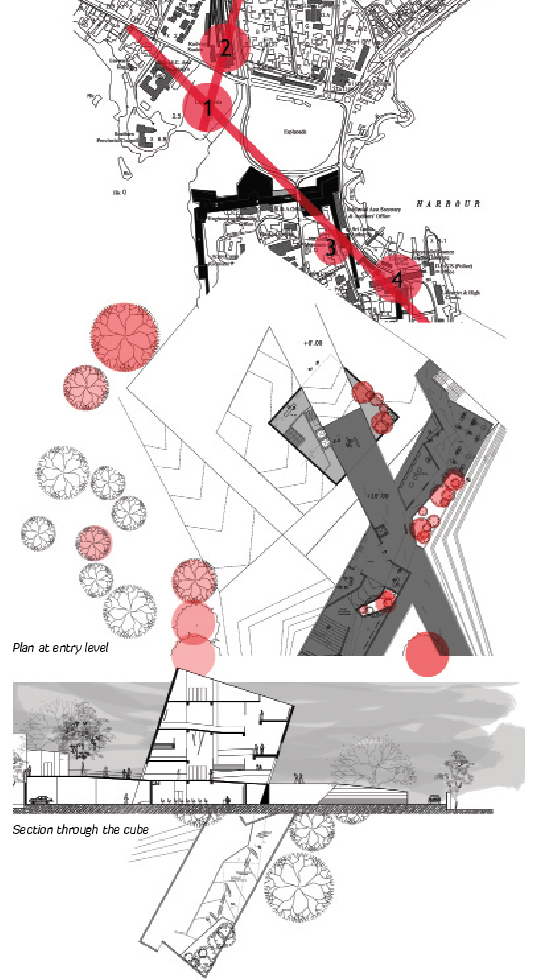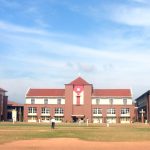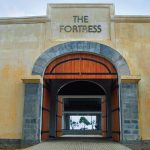-
COLONIAL HISTORY MUSEUM
October 2009
Tracing Colonialism in Galle..
Student : Mutiara Tegal
Institution: City School of Architecture
year 2 part 2 2008-09
The Story of Colonialism: The beginning of colonialism in Sri Lanka might have a definite date but its end still eludes us. It is a story begun that has no end.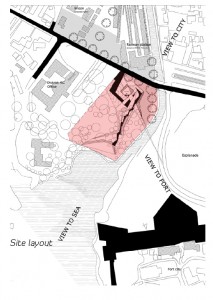
The proposed Museum in Galle attempts not only to remember our colonial past but relate it to the present and the future with the understanding that we cannot know where we are going without knowing where we came from.
The Client; the Galle Heritage Foundation’s requirement was to introduce a museum at Galle that would focus on colonialism in Sri Lanka.
The setting: The site is ideally located in Galle town at Dharmapala Park, at the fore ground of the Galle Fort.
Galle city is the ideal setting as it has been the home to all three colonial rulers; the Portuguese, the Dutch and the British and holds traces of these times as seen in Galle Fort, a place frozen in time and one of the best examples of the many facets of colonialism like its architecture as well as its art and maritime past.
The objective: The museum in the park was designed to understand colonialism and its relevance today. Its programme therefore deals with colonialism at all three periods in time, the past, the present and the future. A visitor is allowed to travel back in time and study the significance of Sri Lanka’s colonial history and its long lasting impact.
The City as a Museum: An initial objective of the proposed museum was to utilise the layers of colonialism in the city of Galle to create a more complete understanding of this subject. The design was also related to several developments proposed for Galle. The new museum would integrate and link the various museum proposals which include the existing Dutch museum within the Fort, the proposed Maritime museum at the old warehouse building and the proposed British Museum at the old railway station.
In order to refine the museum experience for a visitor the new museum in the park was re-programmed to fill in the blanks created by the presence of the other museums. In this regard the new museum was to deal primarily with the Portuguese exhibits while the Dutch and British exhibits will be appropriately housed in buildings of their times. Additional gallery space was included and spaces for the various mediums used for exhibitions e.g. auditoriums and a small cinema were also allocated. Administrative areas as well a library and restaurant were also located in the museum complex.
Another design objective was to link the city to the park / museum and this was achieved by creating a public plaza between the park and the railway station. This also served as an entry court to the museum.
relate a story of our
colonial past
1. Proposed Colonial History Museum
2. Proposed British Museum
3. Existing Dutch Museum
4. Existing Maritime Museum
5. Fort City
The Museum in the Park
1. The Cube
In the design of the museum complex, the first object to be encountered on arriving at the city would be a monument to colonialism, a pure white cube sitting at an uncomfortable angle in the park grounds. The building is meant to
• Attract visitors to the city
• Act as both the entry point and point of termination of the museum sequence.
• Its precarious situation would not only be symbolic of the curiosity and uncertainty of the local people towards the foreign invaders but also of a time warp of being in the past as well as the present.
This upward spiral of time is related through a ramp that extends to the top of the building, the ramp also doubles as gallery space. In this gallery the exhibits maybe from the past but views towards the city have been provided to draw the visitor back to the present.
The building would house an information centre as well as additional gallery space and due to its elevated situation, an observation platform. This final platform would provide a panoramic view of the city, a place that signifies the future.
The Cube will be the main visible built structure in the park.
2. The Museum
The museum and ancillary spaces were buried under the parks new tiered and ramped landscape. The level of the park was raised to hide these buildings while allowing views towards the Fort and opening up views towards the ocean.
This submerged museum would contain the few but precious relics from Portuguese times.
The narrative structure used in the museum includes three parts:
• Creating the right atmosphere
The angled concrete structure of the museum would allow in shafts of light to dramatise the objects within and the high and intimidating spaces would be reminiscent of a cathedral. The spiritual quality of the space will allow a visitor to comprehend the atmosphere created by the colonials who came as told by Vasco da Gama for ‘God and spices’.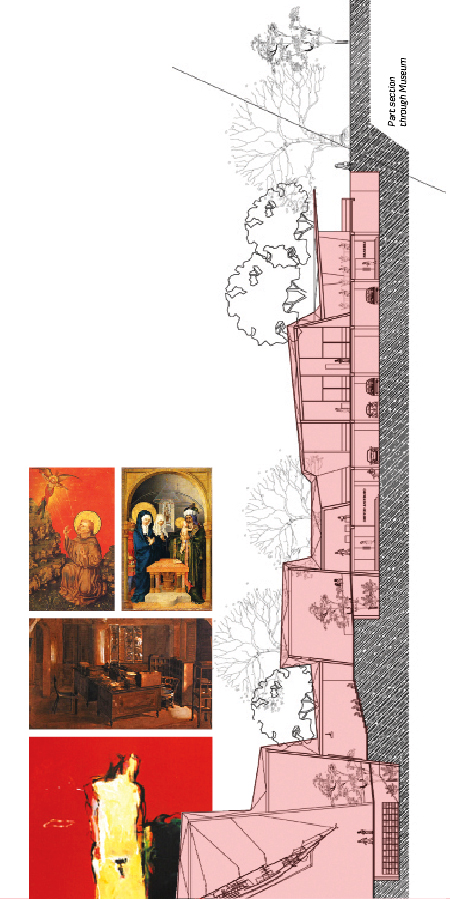
• Using art of the time
To transport visitors through Portuguese colonial times the narration will be supplemented by the projection of art from that period. Art and history have a strong link that the museum will use to reinforce impressions and allow individual interpretations of that time.
• Create intermissions in time
Along this passage of time a visitor’s experience will be interrupted by open courtyards that will remind them of the present and allow them to contemplate the past in relation to the present. These intermissions will allow a visitor to have a more relevant and meaningful visit to the past.
The museum will also rely on various means to impress visitors of Portuguese times as, for example, past the entry lobby, to begin the exhibition, visitors will be confronted with a large suspended ship in a triple height space to signify the sea faring nature of the colonials as well as to mark the nature of their entry onto Sri Lankan shores.
3. The Journey Continues
Visitors will at the end of this phase of the journey be led to an open court from where they may choose to continue their search into colonial times by continuing to the Dutch Museum at the Galle Fort, a path was landscaped towards the esplanade of the Galle Fort. The visit to the Fort, a natural museum piece, as well as the existing Dutch Museum and the proposed Maritime Museum will reveal further layers of colonialism. From this point, visitors will be directed to the railway station, a contribution by the British that will be developed as a museum for British colonial times. Directly opposite this building is the park with the cube and museum and a visitor would have the opportunity to evaluate and interpret the whole experience here. He might understand his role in the story and will be able to appreciate the twists in the story of Colonialism in Sri Lanka
Tracing Colonialism in Galle..
Student : Mutiara Tegal
Institution: City School of Architecture
year 2 part 2 2008-09
The Story of Colonialism: The beginning of colonialism in Sri Lanka might have a definite date but its end still eludes us. It is a story begun that has no end.
The proposed Museum in Galle attempts not only to remember our colonial past but relate it to the present and the future with the understanding that we cannot know where we are going without knowing where we came from.
The Client; the Galle Heritage Foundation’s requirement was to introduce a museum at Galle that would focus on colonialism in Sri Lanka.
The setting: The site is ideally located in Galle town at Dharmapala Park, at the fore ground of the Galle Fort.
Galle city is the ideal setting as it has been the home to all three colonial rulers; the Portuguese, the Dutch and the British and holds traces of these times as seen in Galle Fort, a place frozen in time and one of the best examples of the many facets of colonialism like its architecture as well as its art and maritime past.
The objective: The museum in the park was designed to understand colonialism and its relevance today. Its programme therefore deals with colonialism at all three periods in time, the past, the present and the future. A visitor is allowed to travel back in time and study the significance of Sri Lanka’s colonial history and its long lasting impact.
The City as a Museum: An initial objective of the proposed museum was to utilise the layers of colonialism in the city of Galle to create a more complete understanding of this subject. The design was also related to several developments proposed for Galle. The new museum would integrate and link the various museum proposals which include the existing Dutch museum within the Fort, the proposed Maritime museum at the old warehouse building and the proposed British Museum at the old railway station.
In order to refine the museum experience for a visitor the new museum in the park was re-programmed to fill in the blanks created by the presence of the other museums. In this regard the new museum was to deal primarily with the Portuguese exhibits while the Dutch and British exhibits will be appropriately housed in buildings of their times. Additional gallery space was included and spaces for the various mediums used for exhibitions e.g. auditoriums and a small cinema were also allocated. Administrative areas as well a library and restaurant were also located in the museum complex.
Another design objective was to link the city to the park / museum and this was achieved by creating a public plaza between the park and the railway station. This also served as an entry court to the museum.
Connect the museums…
relate a story of our
colonial past
1. Proposed Colonial History Museum
2. Proposed British Museum
3. Existing Dutch Museum
4. Existing Maritime Museum
5. Fort City
The Museum in the Park
1. The Cube
In the design of the museum complex, the first object to be encountered on arriving at the city would be a monument to colonialism, a pure white cube sitting at an uncomfortable angle in the park grounds. The building is meant to
• Attract visitors to the city
• Act as both the entry point and point of termination of the museum sequence.
• Its precarious situation would not only be symbolic of the curiosity and uncertainty of the local people towards the foreign invaders but also of a time warp of being in the past as well as the present.
This upward spiral of time is related through a ramp that extends to the top of the building, the ramp also doubles as gallery space. In this gallery the exhibits maybe from the past but views towards the city have been provided to draw the visitor back to the present.
The building would house an information centre as well as additional gallery space and due to its elevated situation, an observation platform. This final platform would provide a panoramic view of the city, a place that signifies the future.
The Cube will be the main visible built structure in the park.
2. The Museum
The museum and ancillary spaces were buried under the parks new tiered and ramped landscape. The level of the park was raised to hide these buildings while allowing views towards the Fort and opening up views towards the ocean.
This submerged museum would contain the few but precious relics from Portuguese times.
The narrative structure used in the museum includes three parts:
• Creating the right atmosphere
The angled concrete structure of the museum would allow in shafts of light to dramatise the objects within and the high and intimidating spaces would be reminiscent of a cathedral. The spiritual quality of the space will allow a visitor to comprehend the atmosphere created by the colonials who came as told by Vasco da Gama for ‘God and spices’.
• Using art of the time
To transport visitors through Portuguese colonial times the narration will be supplemented by the projection of art from that period. Art and history have a strong link that the museum will use to reinforce impressions and allow individual interpretations of that time.
• Create intermissions in time
Along this passage of time a visitor’s experience will be interrupted by open courtyards that will remind them of the present and allow them to contemplate the past in relation to the present. These intermissions will allow a visitor to have a more relevant and meaningful visit to the past.
The museum will also rely on various means to impress visitors of Portuguese times as, for example, past the entry lobby, to begin the exhibition, visitors will be confronted with a large suspended ship in a triple height space to signify the sea faring nature of the colonials as well as to mark the nature of their entry onto Sri Lankan shores.
3. The Journey Continues
Visitors will at the end of this phase of the journey be led to an open court from where they may choose to continue their search into colonial times by continuing to the Dutch Museum at the Galle Fort, a path was landscaped towards the esplanade of the Galle Fort. The visit to the Fort, a natural museum piece, as well as the existing Dutch Museum and the proposed Maritime Museum will reveal further layers of colonialism. From this point, visitors will be directed to the railway station, a contribution by the British that will be developed as a museum for British colonial times. Directly opposite this building is the park with the cube and museum and a visitor would have the opportunity to evaluate and interpret the whole experience here. He might understand his role in the story and will be able to appreciate the twists in the story of Colonialism in Sri Lanka

